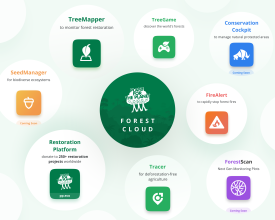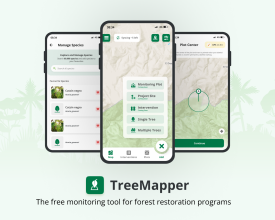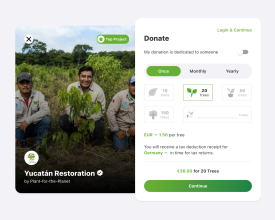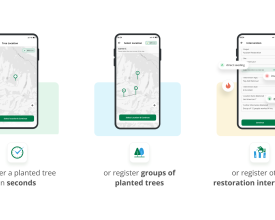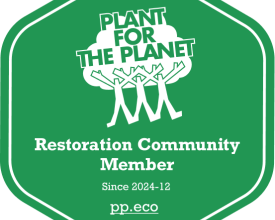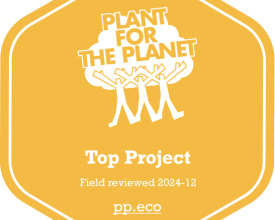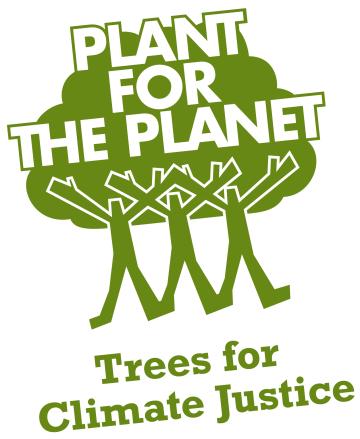
Forest Cloud: A Digital Hub for Global Restoration and Conservation
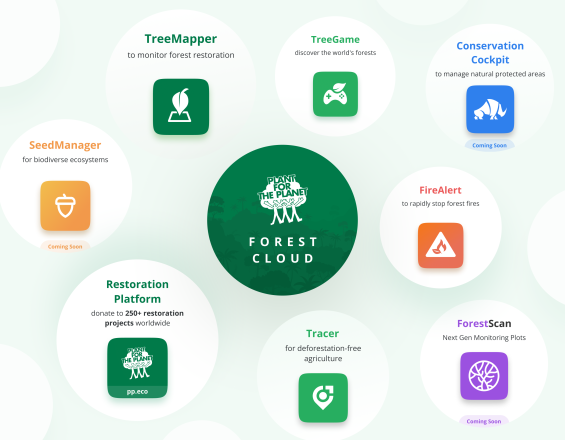
The Restoration Platform, the core of Forest Cloud, transforms global restoration by simplifying fundraising and ensuring transparency for forest conservation. Since 2018, it has evolved to bring back a trillion trees and conserve 3 trillion existing trees. The open-source, open access, digital solution currently supports scientific restoration initiatives as well as managing and coordinating conservation and restoration efforts globally. It benefits from robust Restoration Standards, proprietary restoration monitoring applications, a robust peer-review system and an ecosystem of ancillary digital solutions - the ‘Forest Cloud’. Proven across 300 restoration initiatives and growing, the Platform unifies restoration organizations (ROs), donors, and scientists. Having demonstrated its success by restoring over 94M trees in 6 years, we now seek to improve its scale and geographic reach and solve the logistical challenges to contribute to a sustainable, thriving future.
Context
Challenges addressed
A big source of failure for restoration and conservation initiatives are keeping up-to-date with science and finding financial sustainability. The Restoration Platform addresses these challenges by offering ROs access to a global fundraising platform with an intuitive donation process, but also by improving initiatives to peer-reviewed grounded-in-science Restoration Standards. This ensures that only high quality and credible projects are showcased and gets incentivised. In the daily operations, the usage of TreeMapper enables detailed tree inventories (species, GPS location, diameter at breast height), digitized reporting, and ongoing monitoring, all accessible via an individual dashboard or publicly visualized. Combined with satellite imagery, robust standards, and free advisory services, the platform empowers projects to improve in real-time, enhancing design, implementation, and impact monitoring. By fostering forest restoration, it also contributes to improved livelihoods of indigenous and local communities
Location
Process
Summary of the process
The Restoration Platform, with its due diligence process and advisory services, ensures that projects align with our standards and goals while delivering reliable, trustworthy data. Scientifically validated results from on-site evaluations further enhance transparency.
As part of Forest Cloud, the platform connects donors with restoration organizations and offers a user-friendly donation management and analysis dashboard. Through the integration of on-the-ground data collected via TreeMapper, publicly accessible and analyzable using the DataExplorer dashboard, the platform drives operational excellence for restoration organizations.
Another powerful tool, FireAlert, provides real-time, reliable data to detect forest fires early and monitor restoration and conservation sites of platform projects. Finally, TreeMapper simplifies reporting, enabling organizations to showcase their projects’ results and impact directly to donors through the platform.
Building Blocks
Forest ecosystem restoration and conservation platform
The Restoration Platform (alternatively ‘platform’) is an open-source, open-access digital solution designed to support and coordinate global restoration and conservation efforts. Built with the ambitious goal of restoring a trillion trees and conserving three trillion existing trees, the Platform connects donors, restoration organizations, and researchers in a collaborative network that enhances transparency, accessibility, and impact.
For donors, the platform offers an intuitive and seamless donation process, backed by rigorous due diligence and science-based quality checks, ensuring contributions support credible, high-impact initiatives. Real-time satellite imagery and progress reports enhance transparency, fostering trust and providing donors with a meaningful connection to the projects they fund.
For restoration organizations, the platform provides global visibility, sustainable funding opportunities, and advanced tools for monitoring and reporting on-the-ground impact. Integrated features like the DataExplorer dashboard and TreeMapper enable effective project management and data tracking. FireAlert offers real-time forest fire detection, ensuring swift action to protect restoration sites.
With over 75,000 active users and nearly 300 verified projects from 190 organizations across 64 countries, the platform has become a trusted hub for restoration and conservation. By bridging donors, implementing organizations, and science, it empowers stakeholders to restore ecosystems, combat forest loss, and drive measurable environmental impact.
Enabling factors
Year-round participation: Application and onboarding enables us to cater wider user-base and their needs.
User-Friendly Design: Providing an intuitive and seamless data-driven experience for donors and project implementers, from making donations to tracking project progress seamless to all users and externals.
Global Accessibility: Offering multilingual support, open-source tools, and compatibility with diverse payment systems to cater to a worldwide audience and varying needs.
Continuous Innovation: Regularly updating features, user interface and integrating emerging proven technologies (e.g., artificial intelligence, remote sensing, API) to improve transparency, monitoring, and engagement.
Lesson learned
Key Lessons Learned
Trust Requires Transparency: Rigorous due diligence and clear communication of project data are critical to building and maintaining trust among donors and project implementers. A lack of transparency can deter engagement and long-term support.
User-Centric Design is Essential: Early feedback from donors and restoration organizations highlighted the importance of an intuitive interface and seamless workflows. Complex or confusing processes can discourage platform adoption.
Scalability Requires Preparation: As the platform grew, managing increased demand for support, verification, and monitoring tools proved challenging. Building scalable infrastructure and processes from the outset is one important factor to scale.
Localized Support Boosts Engagement: Offering multilingual interfaces and region-specific features was key to attracting global users. Failing to address local needs initially hindered participation in some regions.
Aspects That Haven’t Worked
One-Size-Fits-All Approach: Assuming all users, globally, have the same needs and expertise to understand and appreciate the criticality of restoration approaches, led to disengagement. Tailoring experiences for individual donors and restoration organizations is critical.
Overcomplicating Features: Early versions included too many tools, overwhelming users. Simplifying and prioritizing essential functionalities improves adoption.
Advice for Replication
Invest in Early User Research: Understand the needs of all stakeholders (donors, implementers, scientists) before development begins to avoid costly redesigns later.
Prioritize Scalability and Flexibility: Design systems that can handle growth and adapt to diverse regional requirements from the start.
Focus on Community Building: Foster a sense of shared mission among users to drive engagement and collaboration.
Iterate Based on Feedback: Regularly gather feedback and use it to refine features, ensuring the platform evolves with user needs.
Organization due diligence and project verification
Restoring forests is a complex and long-term endeavor that requires a holistic approach. To address this, Plant-for-the-Planet has developed its own minimum and top-tier ‘Standards’ for various restoration methods (reforestation, agroforestry, and assisted natural regeneration) that consider biological, social, and economic factors. Organizations and their projects undergo a rigorous verification process during onboarding and are evaluated against these ‘Standards’. Only those meeting the minimum ‘Standards’ are featured on the platform and allowed to actively collect donations. At first stage, the proposals are reviewed by in-house expertise.
In the second phase of due diligence, external experts visit the projects for on-site evaluations based on the established standards. These evaluation results are then reviewed, discussed, and ultimately assessed by an independent, voluntary panel of experts - the so-called Review Board.
This thorough process ensures that only high-quality, impactful projects are showcased and supported through our platform, fostering trust and delivering meaningful results. At the same time, Plant-for-the-Planet remains committed to continuously questioning, reviewing, and refining these standards, integrating the latest scientific research findings to ensure their effectiveness and relevance.
Enabling factors
Clear and Comprehensive Standards: Establishing robust, well-defined criteria for different restoration approaches that incorporate ecological, social, and economic factors is essential for consistency and credibility.
Thorough Verification Process: A rigorous verification process during onboarding ensures that only projects meeting the standards are featured, building trust among donors and ensuring high-quality initiatives.
Expert Involvement and Independent Evaluation: External experts play a critical role in assessing projects on-site, and an independent panel ensures impartial, transparent evaluation, further strengthening the credibility of the platform.
Commitment to Continuous Improvement: Regularly reviewing and updating standards based on the latest scientific findings ensures the platform remains relevant, adaptive, and aligned with current best practices in forest restoration.
Stakeholder Engagement and Transparency: Clear communication with project owners, and experts, along with a transparent evaluation process, fosters trust and ensures ongoing support for high-quality projects.
Financing and sustainability: The in-house project reviewers and on-ground evaluation are paid through Grants from Plant-for-the-Planet Foundation. A white-label version of the Restoration Platform—such as trees.salesforce.com—also serves as a fundraising tool to support broader ForestCloud operations. As the volume of users and applications grows over time, we may introduce a small percentage-based fee on donations to help sustainably cover maintenance and operational costs.
Lesson learned
Key Lessons Learned
Rigorous Standards Ensure Credibility: The importance of developing and maintaining clear, robust standards cannot be overstated. Well-defined criteria for different restoration approaches are crucial to ensure that only high-quality projects are featured. Without strong guidelines, it’s difficult to build trust among donors and other stakeholders.
Expert Involvement is Essential: Engaging external experts for on-site evaluations adds an important layer of credibility to the platform. Their independent assessments help ensure that projects meet the required standards and provide valuable insights into the feasibility and effectiveness of restoration efforts.
Continuous Improvement is Crucial: Regularly reviewing and updating the standards based on new scientific findings and real-world experiences ensures that the platform evolves and stays relevant. This commitment to continuous improvement fosters long-term success and adaptability in a rapidly changing field.
Aspects That Haven’t Worked
Overly Complex Verification Processes: Initially, the verification process was more cumbersome than expected, causing delays in project onboarding. This was a barrier to scaling, especially for smaller organizations with limited resources. Streamlining the verification process without compromising on quality could improve efficiency.
Inconsistent Stakeholder Engagement: At times, communication with some stakeholders — particularly local project implementers — was less frequent, which created gaps in feedback and adjustments. Ensuring more consistent engagement and collaboration throughout the verification and monitoring process would enhance the overall success.
Advice for Replication
Build Clear, Scalable Systems Early: Developing clear, scalable processes from the start can help avoid bottlenecks and inefficiencies down the line. Make sure your verification and evaluation systems can handle growth and adapt to new challenges.
Simplify the Verification Process: While rigor is important, consider building flexibility into the process so that it doesn’t become a barrier to entry. This can help support a broader range of projects while maintaining quality.
Ensure Strong Communication with All Stakeholders: Regular, transparent communication with all involved parties—including donors, project implementers, and experts—is essential. Establish clear lines of feedback and engagement to foster collaboration and ensure that everyone is aligned on the platform’s goals.
Invest in Continuous Learning: Make room for iterative improvements. Learn from both successes and challenges, and adapt the platform’s processes and standards as you gather new data and insights.
Resources
Improved monitoring and reporting efforts for restoration
Environmental restoration initiatives must demonstrate the impact of their efforts to donors and other stakeholders. However, many projects struggle with collecting and presenting data effectively. This is where the digital tools TreeMapper and the DataExplorer dashboard provide invaluable support. TreeMapper enables restoration organizations to collect detailed on-site data about their restoration activities, beyond just tree planting. It can track interventions such as firebreaks, topsoil removal, or other ecosystem restoration measures. With an extensive database of over 60,000 species*, offline functionality, and the ability to re-measure monitoring plots, TreeMapper simplifies ecosystem monitoring and ensures comprehensive, reliable data collection.
Collected data is automatically uploaded to the platform, and publicly accessible within each project profile. For deeper analysis, restoration organizations can use the DataExplorer dashboard or export the data for further exploration in Python or Excel, gaining insights to improve their efforts.
Additionally, satellite data from NASA, European Space Agency, and other providers enhances monitoring by verifying project claims and tracking changes in biomass, tree cover, carbon sequestration, and risks like fire or flooding. This combination of on-the-ground and remote sensing data provides a detailed, comprehensive view of project quality and development over time, empowering stakeholders with transparency and actionable insights.
*BGCI 2024. GlobalTree Portal. Botanic Gardens Conservation International. Richmond, U.K. Available at https://www.bgci.org/resources/bgci-databases/globaltree-portal/. Accessed on 11/12/2024.
Enabling factors
Robust and User-Friendly Tools: Digital tools like TreeMapper and DataExplorer must be intuitive, reliable, and functional in diverse environments, including offline scenarios, to ensure widespread adoption and effective data collection.
Comprehensive Data Integration: Seamless integration of ground-collected data with remote sensing datasets (e.g., from NASA and ESA) ensures a holistic view of project performance and ecosystem development.
Extensive Species Database: A well-maintained and expansive database, such as TreeMapper’s 60,000+ species catalog, is essential for accurate and detailed ecological monitoring.
Accessibility and Scalability: Tools should be accessible to projects of varying sizes and resources, with scalability to handle diverse restoration activities and large datasets as projects grow.
Transparent Data Presentation: Making project data publicly available in a clear and engaging format fosters trust among donors and stakeholders while promoting accountability.
Lesson learned
Key Lessons Learned
Ease of Use is Crucial: Tools like TreeMapper and DataExplorer must prioritize user-friendliness to ensure adoption. Complex interfaces or workflows hinder usage, especially in regions with limited technical capacity.
Offline Capabilities Are Essential: Many restoration projects are conducted in remote areas with unreliable internet. Offline functionality in tools like TreeMapper has been pivotal for data collection in such environments.
Integration of Ground and Satellite Data Enhances Impact: Combining on-the-ground data with satellite insights significantly improves monitoring accuracy and provides a holistic view of project progress, which is critical for both implementers and donors.
Transparency Builds Trust: Publicly accessible and visually processed data strengthens donor confidence and promotes accountability, showcasing the impact of funded initiatives clearly.
Connectivity always a major consideration: Tools built are very light, so they work on old phones, and don't require cutting edge processors. All apps work offline, for instance, TRACER mapping is offline, TreeMapper data can be collected offline, and user only needs internet connectivity every month or so.
Financing and sustainability: ForestCloud's technical infrastructure is backed by a stable, long-term institutional partnership with Plant-for-the-Planet, Salesforce, and ESRI. A white-label version of the Restoration Platform—such as trees.salesforce.com—also serves as a fundraising tool to support broader ForestCloud operations. As the volume of users and applications grows over time, we may introduce a small percentage-based fee on donations to help sustainably cover maintenance and operational costs.
Aspects That Haven’t Worked
Inconsistent Data Collection Practices: Projects initially lacked standardized data collection protocols, which complicated integration and analysis.
Limited Early Training Support: Insufficient training materials and support initially hindered effective use of the tools.
Advice for Replication
Focus on Core Needs First: Begin with essential functionalities that directly address user needs and gradually expand features based on user feedback and evolving requirements.
Standardize Data Collection: Implement clear, uniform guidelines for data collection and reporting standards to ensure consistency across projects.
Offer Extensive Training and Support: Provide user-friendly training resources, tutorials, and ongoing technical support to help implementers fully utilize the tools.
Adapt Tools to Local Contexts: Consider regional variations in restoration practices and environments to ensure tools are versatile and relevant across diverse settings.
Prioritize Transparent Communication: Make project data accessible and understandable for all stakeholders, fostering trust and engagement.
Resources
Strengthening community engagement and expert knowledge
With our platform and tools, we not only provide opportunities to raise funds, simplify data collection for monitoring, and detect forest fires earlier to enable faster response, but also foster a sense of ownership for small grassroots projects tackling the globally critical issue of the climate crisis. Each project on our platform is encouraged to share its challenges and success stories with us and the broader community. This engagement happens through regular Community Talks or direct connections with other projects facing similar challenges, fostering meaningful discussions and facilitating valuable knowledge exchange at both local and regional levels.
Our project badges further enhance this sense of belonging, serving as both a symbol of community membership and an official seal of quality for potential supporters. Additionally, our free and confidential advisory service offers Restoration Organizations tailored guidance from our team of experts, empowering them to sustainably develop and improve their initiatives.
Enabling factors
Active Community Engagement: Regular opportunities for interaction, such as Community Talks and peer connections, are essential for fostering collaboration, knowledge sharing, and mutual support among projects.
Training and Support: Providing training and ongoing technical support to project implementers ensures they can maximize the tools' capabilities and interpret the data effectively.
Recognition and Validation: Tools like project badges that serve as symbols of quality and credibility are important for both community morale and attracting potential supporters.
Tailored Advisory Support: Offering accessible, expert-driven, and confidential guidance ensures projects can address their unique challenges and make sustainable improvements.
Accessible Technology and Tools: User-friendly, reliable tools for fundraising, monitoring, and early detection of challenges like forest fires are vital for grassroots projects to operate effectively and achieve their goals.
Global yet Local Focus: Balancing global relevance with local impact ensures that both the broad climate crisis and specific regional needs are addressed comprehensively.
Lesson learned
Key Lessons Learned
Community Engagement Builds Long-Term Value
Regular interactions through Community Talks and direct peer connections foster a strong sense of belonging and shared purpose. Projects benefit greatly from knowledge exchange, but these forums require consistent facilitation to ensure meaningful participation.
Recognition Drives Motivation and Credibility
Project badges act as an effective tool to recognize and validate project quality, boosting morale among implementers and instilling confidence in donors. However, the criteria for earning badges must be transparent and consistently applied to maintain trust.
Support Must Be Tailored and Accessible
Free advisory services have proven invaluable for projects facing diverse challenges, especially grassroots initiatives with limited resources. However, ensuring adequate capacity within the advisory team to meet growing demand remains critical.
Challenges and Aspects That Did Not Work
Inconsistent Participation in Community Engagement
Not all projects actively participate in discussions or share their experiences, limiting the potential for mutual learning. Encouraging broader involvement remains a challenge.
Balancing Standardization with Flexibility
While project badges and standards provide structure, some grassroots projects felt constrained by rigid criteria that didn’t fully account for local contexts. Introducing adaptability within guidelines has been key.
Advice for Replication
Foster Inclusive Communities
Actively encourage participation in knowledge-sharing initiatives by highlighting benefits and providing incentives for engagement, such as showcasing success stories.
Invest in Scalable Support Structures
Build a robust advisory team and implement scalable processes to accommodate the diverse needs of a growing project community.
Impacts
ForestCloud contributes directly to multiple GBF targets by providing a digital infrastructure that enables restoration, monitoring, fundraising, and knowledge-sharing at scale. It empowers over 75,000 users and supports nearly 300 projects across 64 countries, primarily in biodiversity-rich developing regions like Brazil, Colombia, Kenya, and Indonesia. FireAlert tool monitors 2,984 sites covering 700 million hectares, enabling early wildfire detection and prevention (Target 1, 8). To date, the platform has facilitated the financing of over 94 million trees, while 56 projects have received in-depth restoration advice (Target 2, 10). Restoration is guided by science-based standards aligned with SER, IUCN, UN, and FAO, helping address Target 4. Through TreeMapper, users access a vetted native species database, minimizing the use of invasive species and advancing Target 6. The tool is also a key mechanism for Target 19 and channels donations transparently towards biodiversity conservation, where over 75% of funds directly benefit local men and women equally through employment and participatory restoration. Our open-source tools—FireAlert, TreeMapper, SeedManager—support Target 20 and Target 21, enabling technical cooperation and transparency across all stakeholders.
Beneficiaries
We empower local communities and implementers with data-driven tools to enhance monitoring, and stewardship of forest restoration. Donors benefit from a trusted, transparent system ensuring impactful contributions. Researchers gain insights via ecological data
Additionally, explain the scalability potential of your Solution. Can it be replicated or expanded to other regions or ecosystem?
As an open-source framework, the platform and its software solutions are designed for seamless connection, sharing, and integration. TreeMapper's raw data can be easily exported and utilized wherever needed—whether to enhance the Restoration Platform, for internal purposes, or for academic research. Powerful APIs make these tools highly adaptable, enabling third parties to adopt and improve them. This not only boosts the visibility of global restoration and conservation projects but also enhances monitoring capabilities, driving innovation and impact in the field.
Global Biodiversity Framework (GBF)
Sustainable Development Goals
Story

My name is Julius Sila, a dedicated environmentalist working with Mida Bidii Yetu Na Kazi Restoration Women Group based out of Kenya. I spearhead Mangrove Ecosystem Rehabilitation & Restoration, a community-driven project that aims to restore degraded mangrove forests while empowering local communities to adopt sustainable practices. Before our project was on-boarded onto the Plant-for-the-Planet platform, we faced significant challenges in monitoring, measuring, and reporting on our restoration efforts.
One of our key struggles was accurately documenting our planted sites into digital formats. We relied on traditional, labor-intensive methods that often left room for errors and inconsistencies. Additionally, our forests were at constant risk of wildfires, often triggered by unsustainable practices like honey harvesting using fire in the Avicennia marina mangrove species trunk. These challenges hindered our ability to effectively restore mangroves and protect this vital ecosystem.
Joining the Plant-for-the-Planet Platform brought a transformational change to our work. With the intuitive TreeMapper, we gained the ability to document our planted sites with precision. The platform’s features, such as capturing accurate GPS points, recording tree species planted, and documenting the total number of seedlings, revolutionized how we monitored our sites. Moreover, generating polygons of planted areas in GeoJSON format has been a game-changer for our reporting process. We now submit accurate and transparent restoration data to the Kenya Forest Service, as we’ve adopted a site under their protected forest ecosystem.
Another innovation that significantly impacted our project and surrounding National park is the FireAlert. With its capacity to detect and alert us to fires within a 0 to 5 km radius, we’ve managed to address the wildfire threat effectively. The simple SMS notifications allow us to mobilize a quick response, saving vast tracts of mangrove forests from destruction. This has not only enhanced the health of the ecosystems we protect but has also fostered a sense of security and pride among the community.
Plant-for-the-Planet’s tools have empowered us to bridge the gap between traditional conservation practices and modern technology. Today, we manage our restoration sites with confidence, transparency, and efficiency, enabling us to scale our impact. Moreover, it has enabled us to measure and treasure our progress, making every step of our journey meaningful.

